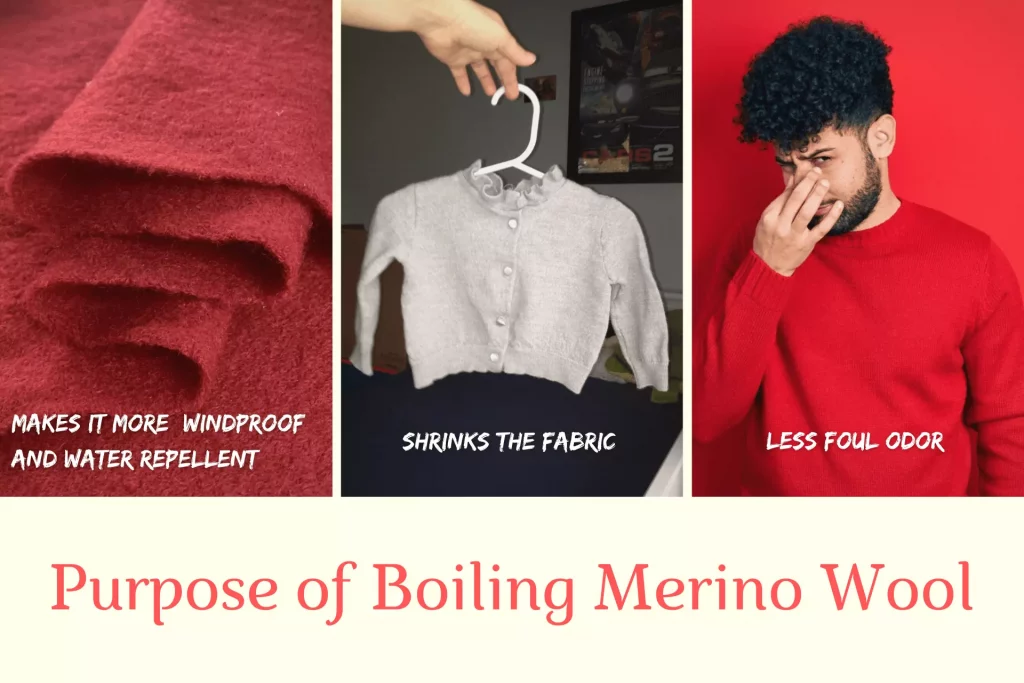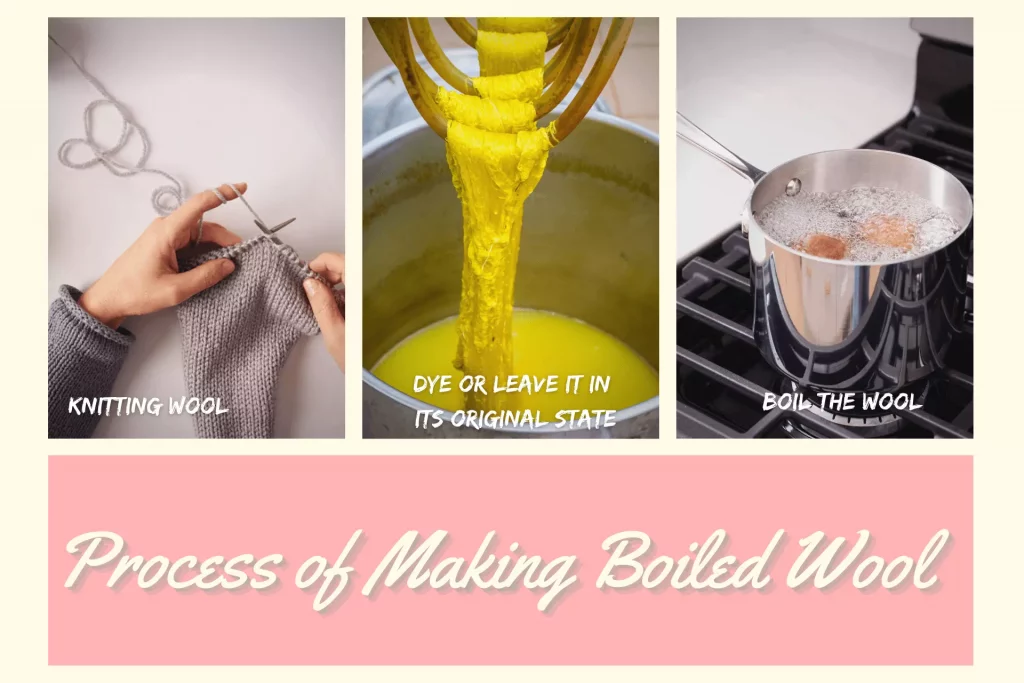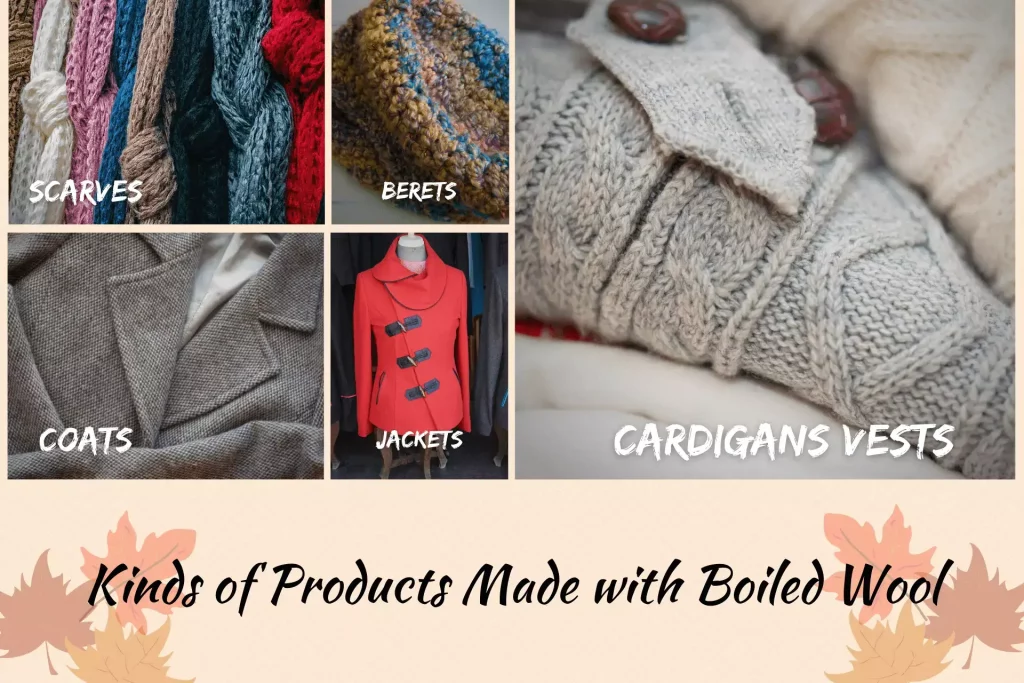Boiled merino wool fabric is the ideal winter companion because of its warmth. Most people are attracted to it because of its warmth and endurance. Wool is an attractive, natural material with excellent qualities right out of the bag and is easy to work with.
These characteristics are further enhanced as a result of the boiling process. Consequently, we have a thick, soft, and long-lasting fabric that is excellent for usage in our high-end goods.
Beanies, shawls, jackets, sweaters, coats, and blazers are items made from boiled Wool most commonly seen on the fashion runway. A procedure known as fulling is used to manufacture this fabric, which involves agitating knit Wool or wool-blend textiles with hot water. Fabric is shrunk during this process, resulting in a thick felted fabric resistant to fraying and subsequent shrinking.
Most people associate Wool with sheep when they think about fiber. But did you know that merino wool can be cooked as well as spun? In this blog post, we’ll take a look at some of the advantages of boiling merino wool, as well as some of the drawbacks. Using boiled merino wool, you can stay toasty all winter long!
Table of Contents
What is Boiling Merino Wool, and How Does it Differ From Other Types of Wool?
The term “boiled wool” refers to the knitted Wool that has been shrunken by soaking it in hot water and soap suds to become felted. Remember the time you washed and dried your wonderful Merino sweater, and it shrunk to a size that was too small for you?
What is the Purpose of Boiling Merino Wool?

Boiled wool is a felted type of Wool that feels denser to the touch than regular Wool. The use of boiling wool is recommended for those seeking a ball of natural, breathable wool that is also more windproof and water-repellent than un-boiled Wool.
The term “boiled wool” refers to knitted Wool shrunken by soaking it in soap suds and hot water to be felted. Recall the time you washed and dried your wonderful Merino sweater, and it shrunk to a size that you didn’t want it to?
Essentially, what you received was boiling Wool – although in a size that was insufficient for your cat! However, that lovely thick wool is what we use to make our boiling wool coats, and yes there isn’t anything like wearing boiled wool clothing to remain warm in the winter!
Moreover, because boiled merino wool contains inherent antibacterial properties, foul odors are less likely to accumulate in the garment; as a result, you don’t need to wash your woolen garment violently, but rather a thorough drying out or a few hours in the freezer will typically suffice.
This also helps maintain your clothing in excellent shape for a longer period. And, of course, it should never be dried in the dryer. Instead, spread it out flat on a towel to dry naturally.
Is Boiling Wool Impervious to Water?
For starters, boiling Wool is a type of knitted fabric. Wool that has been boiled is produced through a process known as fulling. This treatment makes the cloth more robust, compact, and reasonably waterproof.
What is the Process of Making Boiled Wool?

As a starting point, boiling wool fabric is made by knitting wool strands together to make a consistently thick sheet. Boiled Wool is normally produced on a loom, with the wool thread being fed into a big weaving machine as the first step.
After that, you can either dye the fabric or leave it in its original state. Manufacturers also include various decorations and patterns onto their products at this point. Following the weaving process on the loom, the cloth is ready for the fulling process.
This is accomplished by immersing the cloth in hot water, bringing it to a boil, then churning it in a soap-like alkaline for several minutes.
The agitation of the cloth in hot water causes the wool strands to adhere together due to their scaly surface, resulting in a fabric similar to felt. Compared to the pre-boiled wool cloth, you obtain a denser and stiffer material that is significantly smaller.
But why would you boil Wool in the first place? Wool that has been boiled becomes more resistant to water and wind and more durable and warm.
What Kinds of Products are Made with Boiled Wool?

Boiled Wool is an excellent choice for fall and winter clothing, as well as for layering throughout the entire year. In contrast to felted Wool, which is heavier, this Wool is medium in weight. Boiled Wool is primarily utilized in the following products:
- Berets
- Scarves
- Coats
- Cardigans vests
- Jackets
- Blazers
There are several advantages to utilizing boiling wool in producing particular items. For example, in the case of a boiled wool jacket, they can assist the wearer in maintaining an almost constant temperature while wearing the jacket. The fabric has little air pockets that aid in the preservation of heat.
It holds up nicely in adverse weather conditions. Because it is denser than conventional knitted wool fabric, droplets try to roll off the garment rather than absorb the cloth as they would otherwise.
Because the strands have been fused to give it a felted look, they have greater friction resistance. Moreover, because boiling wool is inherently elastic, clothing made of it may retain its shape even after years of use.
Compared to knitted wool materials, fibers that mesh together do not irritate the skin as much as those knitted together.
The Advantages of Boiling Wool Fabric (Boiling Wool Fabric):

Because the intrinsic characteristics of Wool are reinforced even more during the boiling process, there are various advantages to promoting boiled wool fabric over other fabrics. Even additional changes occur during the boiling process, and the Wool becomes:
- A long-lasting and reliable product.
- Breathable.
- Wind-resistant material.
- This material repels dirt and water.
- Insulating.
- Wrinkle-free.
What Is Felted Wool?
Felt is a form of fabric made by felting (also known as wet felting). The original woolen cloth was cut up and physically mixed with another material to form small pieces known as ‘fels’ or shives, which can then be processed into a variety of items such as rugs, carpets, and other similar items using a variety of techniques depending on what you want them to be used for!
Is Boiling Wool and Felted Wool the Same Thing?
Boiled wool is a felted Wool comparable to non-woven Wool felt in appearance and texture. Historically, these procedures may be traced back to at least the Middle Ages.
The term felt derives from the West Germanic word felt, which means “felt.” Wool that has been boiled or felted is distinctive of the traditional textiles of South America and Tyrol, respectively.
Frequently Asked Questions:
Is boiling Wool scratchy to touch?
Boiled wool has a bad reputation for being “scratchy” or “itchy,” and for a good reason. On the other hand, Boiling wool clothes may be quite soft if done correctly and using high-quality Wool. Boiled Wool is not significantly different from ordinary Wool in terms of cleaning or care requirements compared to regular Wool varieties.
Is it possible to wash boiled Wool?
Clothing made of boiled Wool worn next to the skin can be hand-washed in lukewarm water as needed. It is highly recommended that you use a wool detergent designed specifically for Wool. Turn the garment inside out and gently slide it through the water, taking care not to rub, strain, or wring out the cloth as you go.
How many percent of cooked Wool is Wool?
Boiled Wool is an excellent fabric for classic coats, skirts, berets, and other accessories. A foundation wool fabric is used to construct the fabric; then heat washed to generate the finished fabric.
Wool is used in this process because it pre-shrinks the fabric and helps to guarantee that it is ultra-stable and eventually strong, hardwearing, and durable.
Is it necessary to hem boiled Wool?
Wool that has been boiled does not shred and does not require hemming. Before beginning your project, test your length on a scrap of fabric using a ballpoint needle to ensure appropriate. Seams can be pressed flat with a roller or with your fingertips.
Is boiled Wool a soft material?
A small amount of air is retained in the Wool when boiled. It also indicates that it is made of a fabric that enables your skin to breathe, making it extremely comfortable while still being tight. Because it is lightweight and delicate to the touch, it feels wonderful on the skin and does not scrape as some other wool apparel does.
Wrapping it Up:
A new study found that Wool boiled in hot water is less likely to itch. This would be useful for people who are sensitive to the material. It also maintains its shape and durability, which can help with preventing shrinkage or stretching over time.

